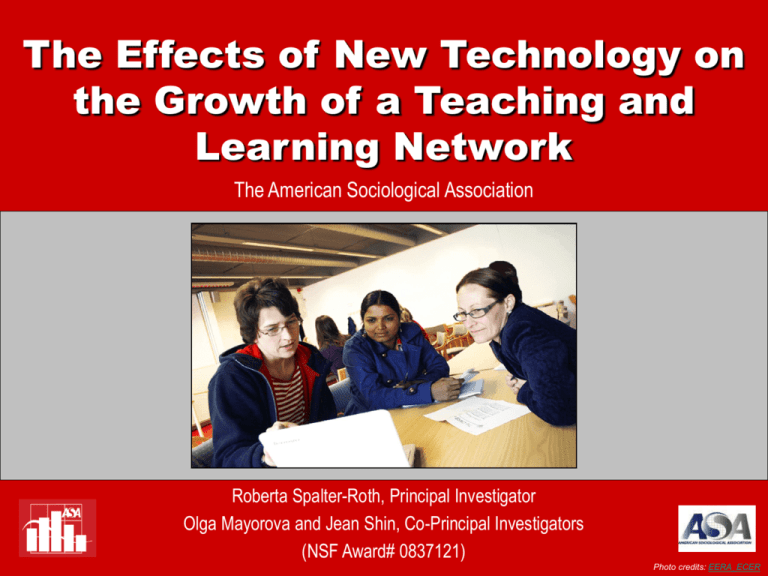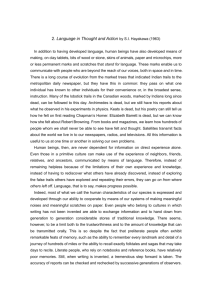The Effects of New Technology on the Growth of a Teaching and
advertisement

The Effects of New Technology on the Growth of a Teaching and Learning Network The American Sociological Association Roberta Spalter-Roth, Principal Investigator Olga Mayorova and Jean Shin, Co-Principal Investigators (NSF Award# 0837121) Photo credits: EERA_ECER 1 What is the role of a teaching and learning network in the dissemination of a new technology and cutting-edge teaching and learning materials? The Research Question After the launching of the new technology, will we see changes in the characteristics of users and the size and structure of a scholarship of teaching and learning network, or must we use social interventions? The Evaluation This National Science Foundation-funded study examines the adoption patterns of the American Sociological Association’s (ASA) new interactive, peer-reviewed Teaching Resource and Innovative Library in Sociology (TRAILS). By comparing TRAILS adopters to users of ASA’s prior paper-based Teaching Resource Center syllabisets, the study asks if there are TRAILS adopters who were not TRC users, whether the characteristics of the users changed, and how the new technology spread. The Effects of New Technology on the Growth of a Teaching and Learning Network 2 What is TRAILS? TRAILS is an online, modular (by topic and type of teaching tool) and searchable database that reflects a major innovation in the creation and dissemination of peer-reviewed teaching resources. At the heart of TRAILS is an extensive electronic database accompanied by a user-friendly search-engine interface to assist in submitting teaching materials (of all media types) and finding teaching materials for various venues, topics, and education levels. The Effects of New Technology on the Growth of a Teaching and Learning Network 3 PURPOSE OF TRAILS 1. To expose faculty members to a wide range of cutting-edge ideas and innovative teaching techniques; and 2. To disseminate cutting edge instructional materials and strategies to a more diverse group of faculty and schools. 3. To increase the size and scope of a scholarship of teaching and learning network through mobilizing new adherents. The Effects of New Technology on the Growth of a Teaching and Learning Network 4 The Problem for the ASA and NSF Need an evaluation to learn: Does a new technology alone lead to more widespread diffusion of cutting-edge teaching and learning materials? Are social interventions necessary? • How are transformational teaching and learning knowledge, curriculum, and practices diffused to faculty in an academic discipline in order to improve student learning? • What are the processes of adoption? • Does a widely-advertised new interactive digital technology lead to widespread adoption by faculty members across all types of universities and colleges? • Does adoption occur slowly and then speed up? • Alternatively does adoption occur through a small, centralized, homophilious network of participants in a scholarship of teaching and learning network and not go beyond this network? • If the later is the case, then are a series of social interventions directed at non-participants necessary? The Effects of New Technology on the Growth of a Teaching and Learning Network 5 RATIONAL FOR STUDY 1. The number of digital science libraries and databases on the internet is growing rapidly. 2. An important subset aims to make cutting-edge science education materials available. 3. Are materials more likely to be diffused through digital libraries than through paper-based libraries? 4. Few digital libraries use evaluation techniques. 5. Does dissemination occur through networks? 6. Are social interventions necessary to increase the scope and characteristics of users? 7. Existing literature suggests that diffusion of innovative teaching materials is a social not a technological process alone. Social strategies are required to broaden the diffusion of materials to a wider network of users. The Effects of New Technology on the Growth of a Teaching and Learning Network 6 SOURCES In collecting data for this project, we relied on unobtrusive methods and secondary data. The primary source of data is the ASA membership database, which includes information on members’ demographic characteristics, including gender and education; institutional characteristics of members’ employers; participation in ASA activities; and purchase of materials and other services. In studying the TRC, we included 5,445 faculty members who in 2008 were ASA regular, associate, or emeritus members; employed by a U.S. higher education institution; and in a full-time or part-time teaching position. Missing information was obtained through web searches by looking up faculty CVs, biographies on departments’ web pages, etc. In studying TRAILS, we included 5,324 faculty members who were members in 2010. The Effects of New Technology on the Growth of a Teaching and Learning Network 7 METHODS We used a multi-method approach to test the study hypotheses: NETWORK ANALYSIS Network analysis is distinguished by the attention it pays to the links and relations among actors, organizations, and activities within a social system (Rogers 2003; Wasserman and Faust 1994). Prior social ties are seen as the basis for recruitment and diffusion that is thought to occur along existing lines of interaction (Diani and McAdam 2003). Those networks with dense ties are viewed as the most successful in bringing about change (Rogers 2003). We use an affiliation network design to determine if the network of teaching and learning scholars in sociology in 2008 would be the primary method of adoption of TRAILS. An affiliation network captures relationships between individuals who are linked to each other by a set of overlapping group memberships (affiliations). Two individuals are assumed to be connected when they participate in at least one activity together. REGRESSION ANALYSIS In addition to network analysis, we conducted multivariate regression analyses to enrich the findings from the network analysis. We investigated the significant characteristics of those who purchased TRC materials in 2008 and later, the significant characteristics of those who subscribed to TRAILS in 2010. Because the dependent variable is dichotomous, we employed logistic regression as the most appropriate statistical tool for this set of analyses. The Effects of New Technology on the Growth of a Teaching and Learning Network 8 Hypothesis 1: During the first year after the launch of TRAILS, we will not see changes in the characteristics of the users because the availability of technology alone does not change usage patterns. The Effects of New Technology on the Growth of a Teaching and Learning Network 9 FINDINGS • TRAILS subscribers tend to have almost the same characteristics as did TRC purchasers. TRAILS subscribers just as TRC purchasers are more likely to be women and pre-tenure faculty, who teach at Baccalaureate-only or master’s comprehensive schools. • A slight shift occurred toward widening the gap between users and non-users of teaching and learning materials. African American faculty and faculty in the South and West of the country were less likely to subscribe to TRAILS, while this was not the case for the purchase of paper-based TRC materials. The Effects of New Technology on the Growth of a Teaching and Learning Network 10 The Effects of New Technology on the Growth of a Teaching and Learning Network 11 Hypothesis 2: TRAILS Adoption Patterns: We expected that the teaching and learning network post TRAILS would have the same characteristics as before because there was not enough time for the network to change in the first twelve months after the launch of TRAILS. The Effects of New Technology on the Growth of a Teaching and Learning Network 12 Number of Participants in ASA-Sponsored Teaching and Learning Activities in 2008 and 2010. Type of Activity Number of Participants Consumption Activities 2008 2010 Subscribed to Teaching Sociology 1,010 898 Was a member of the Teaching & Learning Section 436 430 Bought TRC materials in 2008 or subscribed to TRAILS in 2010 365 316 DRG (Department Resource Group) member 36 31 Participated in teaching and learning task force groups 35 7 Served on the Teaching and Learning Section’s committees a 37 46 Served on the editorial board for Teaching Sociology 29 34 Reviewed for Teaching Sociology 93 90 Published at least one article in Teaching Sociology 53 51 Presented teaching and learning research at ASA’s Annual Meeting 54 19 Led a teaching and learning workshop at ASA’s Annual Meeting 40 14 Edited TRC materials in 2008 or for TRAILS in 2010 6 26 134 7 Total faculty in the teaching and learning network 1,490 1,260 Total faculty in the study 5,445 5,234 Production Activities Contributed to TRC materials in 2008 or to TRAILS in 2010 Totals a Includes Section officers and committee members. The Effects of New Technology on the Growth of a Teaching and Learning Network 13 2010 Sociology Teaching and Learning Network N=1,260 Legend Activities Research I High Research/Doctoral Masters TS Subscriber Bachelors Two-year Other TS Reviewer TS Teaching Sociology T&L Teaching and Learning TS Editorial Board T&L Workshop T&L Taskforce The Effects of New Technology on the Growth of a Teaching and Learning Network 14 FINDINGS THE 2010 NETWORK: After the implementation of TRAILS the density of the teaching and learning network remained about the same. • The network’s density remained much the same (an average of 1.6 activities per person). • The networks core remains small. 62 faculty (five percent of all network members) are involved in two or more production activities. • TRAILS subscribers are slightly more embedded within the network than users of TRC materials in 2008: 53% of TRAILS subscribers are involved in some other teaching and learning activities compared to 47% for TRC users. • Faculty from non-research institutions of higher education continue to dominate the network and its core: • Just as in 2008, women get involved in more teaching and learning activities, as do faculty from non-research universities, and faculty from the Midwest. • Just as in 2008, racial/ethnic minorities, early career faculty, and faculty members with PhDs are involved in fewer teaching and learning activities. The Effects of New Technology on the Growth of a Teaching and Learning Network 15 Hypothesis 3: We expected that participants in the teaching and learning network would become early adopters of TRAILS. The Effects of New Technology on the Growth of a Teaching and Learning Network 17 FINDINGS • TRAILS adoption is still at its early stages. TRAILS subscribers are still a small minority and can be classified as “early adopters” according to Rogers (2003). • The total percent of TRAILS subscribers among all sociology faculty in September, 2011 was 9.5%, which is higher than the rate of the paper-based materials. • The subscription rate to TRAILS does not appear to follow the Sshaped curve of the typical diffusion of innovation process as described by Rogers (2003). The First Year of TRAILS Adoption by Sociology Faculty in 2010-11 ASA Membership Years (N=6,519) 100 90 80 70 60 50 40 30 20 10 0 May, 2010 Sept, 2010 Typical Adoption Curve TRAILS Adoption The Effects of New Technology on the Growth of a Teaching and Learning Network 22 FINDINGS Cumulative Percent of TRAILS Adopters among Sociology Faculty, May 2010 through May 201 20.0 Total Percent Subscribed 18.0 16.0 14.0 12.0 10.0 • Prior users of TRC materials are 4 times as likely to be TRAILS subscribers as those who did not participate in the teaching and learning network. 40% of all early adopters of TRAILS also purchased hardcopy TRC materials. 8.0 6.0 4.0 2.0 -1 1 ay M r-1 1 Ap -1 1 ar M -1 1 1 Fe b 0 n1 Ja ec -1 10 D ov - -1 0 N 0 p1 O ct 0 Se g1 0 Au l-1 0 Ju n1 Ju M ay -1 0 0.0 Month Bought TRC Materials in 2006-2008 Participated in Teaching and Learning Network in 2006-08 In the department with a TRC 2006-2008 Purchaser No Prior Link to TRC Materials and Teaching and Learning Network • Those who did not buy TRC materials but participated in the teaching and learning network were 2 times as likely to subscribe to TRAILS. 42% of new TRAILS subscribers participated in teaching and learning activities between 2006 and 2008. The Effects of New Technology on the Growth of a Teaching and Learning Network 16 FINDINGS • The users of TRC materials adopted TRAILS more quickly and continued to adopt for a longer period of time. Adoption by the other groups leveled off more quickly. • Non-participants in the Teaching and Learning network were significantly less likely to adopt TRAILS, with departmental colleagues of network members somewhat more likely to adopt. • Although network membership had a positive impact for TRAILS adoption, the reverse was not true. After the implementation of TRAILS the size (25% of all sociology faculty) and density of the teaching and learning network in sociology remained the same (1.6 activity, on average). The Effects of New Technology on the Growth of a Teaching and Learning Network 19 FINDINGS 140 120 100 80 60 40 20 0 ay -1 Ju 0 n1 Ju 0 l-1 Au 0 gSe 10 p1 O 0 ct -1 No 0 v1 De 0 c1 Ja 0 n1 Fe 1 b1 M 1 ar -1 Ap 1 rM 11 ay -1 Ju 1 n11 Ju lAu 11 g1 Se 1 p11 • TRAILS adoption by faculty was the highest during the first month after its launch. 160 M • The diffusion process appears to be governed by dissemination of information activities aimed at raising awareness of TRAILS among sociology and social contacts. 180 Number of New Subscribers The adoption of TRAILS is dependent on the passing of information about it through both social contacts and activities aimed at raising awareness of TRAILS among sociology faculty. TRAILS Adoption in 2010-2011 ASA Membership Years (Not Cumulative) Month U.S. Faculty All Students The Effects of New Technology on the Growth of a Teaching and Learning Network 20 FINDINGS • Two jumps in the number of TRAILS adoptions in August 2010 and January 2011 are related to the start time of the academic semesters. • Cyclical nature of faculty’s teaching needs during the academic year makes adoption levels the highest at the beginning of the academic semester and low through the rest of the year. • A jump in March of 2011 is related to the time when a TRAILS Facebook page was created. • Networks of users of paper-based teaching and learning materials which existed before the TRAILS could have created a word-of-mouth interest in subscribing to the new innovative method for the dissemination of teaching and learning materials. The Effects of New Technology on the Growth of a Teaching and Learning Network 21 FINDINGS Cumulative Percent of TRAILS Adopters among Sociology Faculty, May 2010 through May 201 14.0 • 13% of sociology faculty at Baccalaureate-only level institutions, 11% of faculty at Associate level institutions, and only 4% of Research I institutions subscribed. 12.0 Total Percent Subscribed The adoption rate is much higher among institutions that emphasize teaching. 10.0 8.0 6.0 • The rate of adoption, nevertheless, continues to grow throughout the year at all type of schools except Master’s level schools. 4.0 2.0 Ma y -1 1 Apr - 11 Ma r- 11 Feb - 11 J an -1 1 De c-1 0 No v-1 0 Oc t- 10 Sep - 10 Aug - 10 -10 J ul J un -1 0 Ma y -1 0 0.0 Month Research I High Research/Doctoral Masters Baccalaureate Associate • The results suggest that the new innovation is not moving to high prestige Research I Universities. The Effects of New Technology on the Growth of a Teaching and Learning Network 23 CONCLUSIONS Answers to the evaluation question: 1. The process of adoption of TRAILS occurs through a small, homophilious teaching and learning network. 2. TRAILS dissemination has not occurred across all types of schools. 3. Adoption appears to occur quickly and then slow down, but responds to cyclical teaching needs and to sociology networks. The Effects of New Technology on the Growth of a Teaching and Learning Network 23 NEXT STEPS For the next phase of this study we will examine whether strategic social interventions increase beyond teaching and learning network members and their departmental colleagues. We are particularly interested in learning what strategies increase adoption beyond the institutions that subscribe and the current characteristics of the subscribers. These strategies could, for example, include departmental memberships with discounts to faculty including high research departments and Historically Black Colleges; special invitations to “star’ sociologists to contribute materials to the library and to feature these contributions, and giving awards and advertising awards for best contributions to the library. The Effects of New Technology on the Growth of a Teaching and Learning Network








